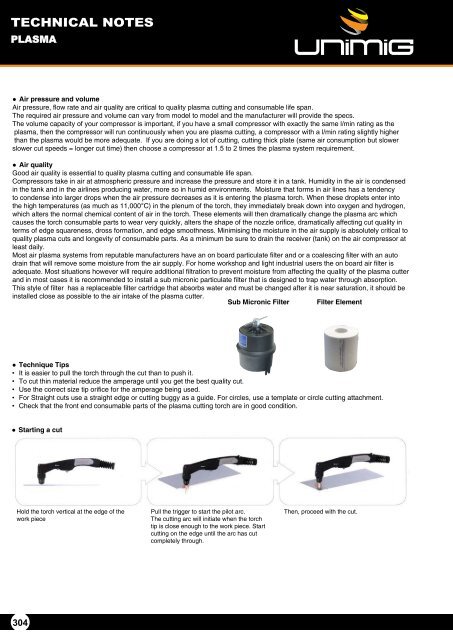You also want an ePaper? Increase the reach of your titles
YUMPU automatically turns print PDFs into web optimized ePapers that Google loves.
TECHNICAL NOTES<br />
PLASMA<br />
Operating Procedure & Techniques for PLASMA Cutting<br />
● Air p<strong>res</strong>sure and volume<br />
Air p<strong>res</strong>sure, ow rate and air quality are critical to quality plasma cutting and consumable life span.<br />
The required air p<strong>res</strong>sure and volume can vary from model to model and the manufacturer will provide the specs.<br />
The volume capacity of your comp<strong>res</strong>sor is important, if you have a small comp<strong>res</strong>sor with exactly the same l/min rating as the<br />
plasma, then the comp<strong>res</strong>sor will run continuously when you are plasma cutting, a comp<strong>res</strong>sor with a l/min rating slightly higher<br />
than the plasma would be more adequate. If you are doing a lot of cutting, cutting thick plate (same air consumption but s<strong>low</strong>er<br />
s<strong>low</strong>er cut speeds = longer cut time) then choose a comp<strong>res</strong>sor at 1.5 to 2 times the plasma system requirement.<br />
● Air quality<br />
Good air quality is essential to quality plasma cutting and consumable life span.<br />
Comp<strong>res</strong>sors take in air at atmospheric p<strong>res</strong>sure and increase the p<strong>res</strong>sure and store it in a tank. Humidity in the air is condensed<br />
in the tank and in the airlines producing water, more so in humid environments. Moisture that forms in air lines has a tendency<br />
to condense into larger drops when the air p<strong>res</strong>sure decreases as it is entering the plasma torch. When these droplets enter into<br />
the high temperatu<strong>res</strong> (as much as 11,000°C) in the plenum of the torch, they immediately break down into oxygen and hydrogen,<br />
which alters the normal chemical content of air in the torch. These elements will then dramatically change the plasma arc which<br />
causes the torch consumable parts to wear very quickly, alters the shape of the nozzle ori ce, dramatically affecting cut quality in<br />
terms of edge squareness, dross formation, and edge smoothness. Minimising the moisture in the air supply is absolutely critical to<br />
quality plasma cuts and longevity of consumable parts. As a minimum be sure to drain the receiver (tank) on the air comp<strong>res</strong>sor at<br />
least daily.<br />
Most air plasma systems from reputable manufacturers have an on board particulate lter and or a coalescing lter with an auto<br />
drain that will remove some moisture from the air supply. For home workshop and light industrial users the on board air lter is<br />
adequate. Most situations however will require additional ltration to prevent moisture from affecting the quality of the plasma cutter<br />
and in most cases it is recommended to install a sub micronic particulate lter that is designed to trap water through absorption.<br />
This style of lter has a replaceable lter cartridge that absorbs water and must be changed after it is near saturation, it should be<br />
installed close as possible to the air intake of the plasma cutter.<br />
Sub Micronic Filter Filter Element<br />
● Technique Tips<br />
• It is easier to pull the torch through the cut than to push it.<br />
• To cut thin material reduce the amperage until you get the best quality cut.<br />
• Use the correct size tip ori ce for the amperage being used.<br />
• For Straight cuts use a straight edge or cutting buggy as a guide. For circles, use a template or circle cutting attachment.<br />
• Check that the front end consumable parts of the plasma cutting torch are in good condition.<br />
● Starting a cut<br />
Hold the torch vertical at the edge of the<br />
work piece<br />
● Hand torch cutting technique<br />
Pull the trigger to start the pilot arc.<br />
The cutting arc will initiate when the torch<br />
tip is close enough to the work piece. Start<br />
cutting on the edge until the arc has cut<br />
completely through.<br />
Then, proceed with the cut.<br />
304


